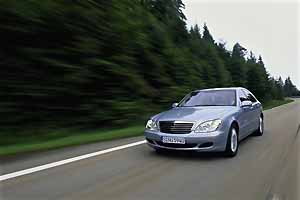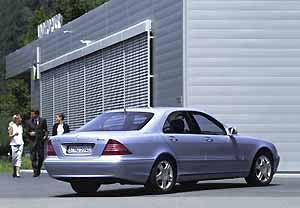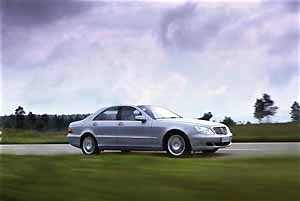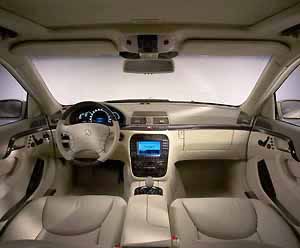
New
twelve-cylinder, twin-turbo engine developing 368 kW/500
hp

Neuer 368 kW/500 PS starker
Biturbo-Zwölfzylindermotor |
Mercedes-Benz S-Class: Setting trends with exclusive,
leading-edge technology
-
Maximised stability and traction in all situations with 4MATIC
-
Largest engine range in luxury-class segment, featuring six high-tech
power plants
-
Six-cylinder models with increased power and torque
-
Subtle design modifications front and rear
-
Exclusive designo couture interior trim package
 Stuttgart
- The pace of technical and stylistic change at the world's number one
manufacturer of luxury-class saloons shows no signs of letting up. Mercedes-Benz
will shortly present an even more attractive and innovative S-Class with
numerous modifications. The facelifted flagship model is due to be unveiled
to the public in autumn 2002. With leading-edge engineering the S-Class,
which made its world debut in autumn 1998, is once again showing itself to
be a role model and trend-setter. Heading the list of high-tech innovations
is the PRE-SAFE pre-crash occupant protection system, with which Mercedes-Benz
is inaugurating a new era in automotive safety. PRE-SAFE can detect an impending
collision in advance and puts the occupants and the vehicle on standby before
an impact occurs. PRE-SAFE occupant protection measures include split-second
advance tensioning of the seat belts, aimed at ensuring the best possible
occupant seating position prior to a collision so that the airbags can do
their job as effectively as possible. At the same time PRE-SAFE automatically
adjusts the front passenger seat and the power-adjustable individual seats
in the rear to a favourable position. If the vehicle is skidding, it also
automatically closes the sunroof. Stuttgart
- The pace of technical and stylistic change at the world's number one
manufacturer of luxury-class saloons shows no signs of letting up. Mercedes-Benz
will shortly present an even more attractive and innovative S-Class with
numerous modifications. The facelifted flagship model is due to be unveiled
to the public in autumn 2002. With leading-edge engineering the S-Class,
which made its world debut in autumn 1998, is once again showing itself to
be a role model and trend-setter. Heading the list of high-tech innovations
is the PRE-SAFE pre-crash occupant protection system, with which Mercedes-Benz
is inaugurating a new era in automotive safety. PRE-SAFE can detect an impending
collision in advance and puts the occupants and the vehicle on standby before
an impact occurs. PRE-SAFE occupant protection measures include split-second
advance tensioning of the seat belts, aimed at ensuring the best possible
occupant seating position prior to a collision so that the airbags can do
their job as effectively as possible. At the same time PRE-SAFE automatically
adjusts the front passenger seat and the power-adjustable individual seats
in the rear to a favourable position. If the vehicle is skidding, it also
automatically closes the sunroof.
 This new
safety system is based on the findings of the Mercedes-Benz accident researchers,
which show that in approximately two thirds of all accidents, there is a
relatively long time lapse between recognition of an impending collision
and the collision itself. Mercedes-Benz is now using this "window" for advance
activation of protection systems in order to further reduce the risk of injury
to the vehicle's occupants. The model-year 2003 S-Class will inaugurate this
pioneering safety concept. PRE-SAFE determines accident probability using
sensors belonging to the Electronic Stability Program ESP®
and Brake Assist whose job is to recognise critical situations at an early
stage. The status of the system components is reversible, i.e. if the accident
is averted at the last moment, the advance seat belt tensioning is automatically
terminated and the occupants are able to reset the position of the seats
and the sunroof. However, PRE-SAFE is instantly ready to go into action again
if required. The system is the result of some six years' intensive development
work by Mercedes engineers. Hundreds of drivers took part in the testing
and refining of PRE-SAFE on test tracks and in the DaimlerChrysler Berlin
driving simulator. This acceptance-testing programme delivered a clear verdict:
pre-crash occupant protection in no way restricts the freedom of the driver
or the drivability of the car but rather gives occupants an enhanced feeling
of safety. This new
safety system is based on the findings of the Mercedes-Benz accident researchers,
which show that in approximately two thirds of all accidents, there is a
relatively long time lapse between recognition of an impending collision
and the collision itself. Mercedes-Benz is now using this "window" for advance
activation of protection systems in order to further reduce the risk of injury
to the vehicle's occupants. The model-year 2003 S-Class will inaugurate this
pioneering safety concept. PRE-SAFE determines accident probability using
sensors belonging to the Electronic Stability Program ESP®
and Brake Assist whose job is to recognise critical situations at an early
stage. The status of the system components is reversible, i.e. if the accident
is averted at the last moment, the advance seat belt tensioning is automatically
terminated and the occupants are able to reset the position of the seats
and the sunroof. However, PRE-SAFE is instantly ready to go into action again
if required. The system is the result of some six years' intensive development
work by Mercedes engineers. Hundreds of drivers took part in the testing
and refining of PRE-SAFE on test tracks and in the DaimlerChrysler Berlin
driving simulator. This acceptance-testing programme delivered a clear verdict:
pre-crash occupant protection in no way restricts the freedom of the driver
or the drivability of the car but rather gives occupants an enhanced feeling
of safety.
Adaptive airbag control takes into
account accident situation and the weight of the front passenger
In a further measure to enhance occupant safety in the S-Class, Mercedes-Benz
uses "up-front sensors" at the front of the body which are able to ascertain
the severity of an accident at an early stage, so that the two-stage front
passenger airbag can respond even more appropriately. The up-front sensors
are also able to activate the belt-tensioners even earlier, thus keeping
the occupants optimally secured during an impact. Also new: the weight of
the front passenger is automatically classified with the aid of a special
membrane in the seat upholstery. The system then decides whether to trigger
one or both passenger airbag stages on the basis not just of accident severity
but also of occupant weight.
4MATIC four-wheel drive system optional
for six- and eight-cylinder models
Helping to raise traction and stability a further notch in the facelifted
S-Class due out in autumn 2002 will be the optional 4MATIC four-wheel drive
system for the six- and eight-cylinder petrol-engined models. On snow or
ice, on slippery cobblestones, in the wet or in other adverse road conditions,
4MATIC provides even greater traction without detracting from typical Mercedes
ride comfort. Combined with ESP®, it allows the driver to
cope safely and confidently in critical situations.
500 hp V12 engine and further improved
six-cylinder engines
 With two six-cylinder engines, three V8s and a V12, the S-Class
offers a wider selection of engines than any other product in this segment.
The output ratings extend from 150 kW/204 hp to 368 kW/ 500 hp in the
range-topping S 600 model. Heading the new engine line-up is a newly developed
twelve-cylinder twin-turbo unit with water-cooled intercooler and other high-tech
innovations. Made of advanced light-weight materials, this 5.5 litre V12
power plant develops a maximum output of 368 kW/ 500 hp, making it one of
the most powerful engines in its class. It delivers peak torque of 800 Newton
metres upwards of just 1800 rpm and propels the top-of-the-line S 600 from
0 to 100 km/h in just 4.8 seconds. With two six-cylinder engines, three V8s and a V12, the S-Class
offers a wider selection of engines than any other product in this segment.
The output ratings extend from 150 kW/204 hp to 368 kW/ 500 hp in the
range-topping S 600 model. Heading the new engine line-up is a newly developed
twelve-cylinder twin-turbo unit with water-cooled intercooler and other high-tech
innovations. Made of advanced light-weight materials, this 5.5 litre V12
power plant develops a maximum output of 368 kW/ 500 hp, making it one of
the most powerful engines in its class. It delivers peak torque of 800 Newton
metres upwards of just 1800 rpm and propels the top-of-the-line S 600 from
0 to 100 km/h in just 4.8 seconds.
The tried-and-tested six-cylinder S-Class engines have been further improved,
with an increase in both power and torque:
-
The displacement of the V6 petrol engine has been increased to 3.7 litres,
bringing a 12.5 per cent increase in output to 180 kW/245 hp, and a 13 per
cent increase in torque to 350 Newton metres at 3000 rpm. The fuel consumption
of the new S 350 remains outstanding for an engine in this size class
at 11.1 litres per 100 km (NEDC combined consumption).
-
The modified six-cylinder diesel engine is one of the second generation of
Mercedes-Benz common rail diesel engines, which combine increased torque
and responsiveness with even greater fuel efficiency. The output of the 3.2
litre engine has been increased to 150 kW/204 hp, while maximum torque has
scaled a new peak at 500 Newton metres at 1800 rpm. The fuel consumption
of the S 320 CDI is just 7.7 litres per 100 kilometres (NEDC combined
consumption) -- four per cent less than before.
Front section restyled for an even
more powerful look
 Visually
too, subtle modifications are the general theme of the model-year 2003 S-Class,
helping to accentuate its lithe and elegant character. For example the front
bumper with restyled lower air intake gives the body a wider, more powerful
appearance. The radiator grille has been redesigned too, and is now taller
and steeper than before. The most important change however concerns the stylish
headlamps, whose state-of-the-art clear lenses and high-brilliance reflectors
add further zest to the appearance of the S-Class. The exterior mirror casings
and the rear lights too, are now more elegantly styled. In the interior over
40 features have been redesigned, or further
enhanced using new materials. Thus passengers can now enjoy higher
standards of comfort and an even more luxurious ambience. Subtle chrome
embellishment on the select wood trim strips, the improved seat upholstery
and the elegant new switches are just three examples of the careful attention
to detail shown during the course of this facelift. Visually
too, subtle modifications are the general theme of the model-year 2003 S-Class,
helping to accentuate its lithe and elegant character. For example the front
bumper with restyled lower air intake gives the body a wider, more powerful
appearance. The radiator grille has been redesigned too, and is now taller
and steeper than before. The most important change however concerns the stylish
headlamps, whose state-of-the-art clear lenses and high-brilliance reflectors
add further zest to the appearance of the S-Class. The exterior mirror casings
and the rear lights too, are now more elegantly styled. In the interior over
40 features have been redesigned, or further
enhanced using new materials. Thus passengers can now enjoy higher
standards of comfort and an even more luxurious ambience. Subtle chrome
embellishment on the select wood trim strips, the improved seat upholstery
and the elegant new switches are just three examples of the careful attention
to detail shown during the course of this facelift.
As a further attraction, Mercedes-Benz now also offers an exclusive "designo
couture" interior trim package, which includes finest-quality nappa and nubuk
leather upholstery, anthracite-coloured poplar or maple wood veneer and a
roof lining of fine Alcantara.
Dynamic multicontour seat for ultimate
lateral support during cornering
 The COMAND
display/operating system is now a standard feature on all S-Class models.
Its 16:9, 6.5" colour display is now larger and thus even easier to scan
at a glance. In the top-of-the-line S 600 model, COMAND includes the navigation
system as standard specification. The seats in the S-Class have been extensively
revised. Softer padding and new upholstery technology now provide even greater
seating comfort for driver and front passenger. As an option, S-Class customers
can now also select the ultimate in state-of-the-art seat technology, in
the form of the innovative dynamic multicontour seat. The dynamic multicontour
seat is equipped with a number of air chambers which are automatically inflated
or deflated to provide superb lateral support on corners for the driver and
front passenger. These operations are controlled electro-pneumatically by
a microprocessor inside the seat which, with split-second speed, processes
data such as steering angle, lateral
acceleration and road speed, then varies the inflation pressure and
volume of the air cushions accordingly. For example on a left-hand bend,
the system automatically pumps up the air cushions on the right-hand side
of the backrest to provide more lateral support. The COMAND
display/operating system is now a standard feature on all S-Class models.
Its 16:9, 6.5" colour display is now larger and thus even easier to scan
at a glance. In the top-of-the-line S 600 model, COMAND includes the navigation
system as standard specification. The seats in the S-Class have been extensively
revised. Softer padding and new upholstery technology now provide even greater
seating comfort for driver and front passenger. As an option, S-Class customers
can now also select the ultimate in state-of-the-art seat technology, in
the form of the innovative dynamic multicontour seat. The dynamic multicontour
seat is equipped with a number of air chambers which are automatically inflated
or deflated to provide superb lateral support on corners for the driver and
front passenger. These operations are controlled electro-pneumatically by
a microprocessor inside the seat which, with split-second speed, processes
data such as steering angle, lateral
acceleration and road speed, then varies the inflation pressure and
volume of the air cushions accordingly. For example on a left-hand bend,
the system automatically pumps up the air cushions on the right-hand side
of the backrest to provide more lateral support.
Market share of between 40 and 58 per
cent in the main market regions
Some 320,000 drivers from all over the world have now opted for an S-Class
since this model series first went on the market in late 1998. In all regions,
the S-Class has secured a leading position in its segment. In Western Europe,
the flagship Mercedes model accounts for some 46 per cent of new luxury-class
registrations, in the USA for some 40 per cent and in Japan for 58 per cent.
The S-Class has also picked up, at the latest count, around four dozen
international awards and distinctions. It has repeatedly been awarded titles
like "best car, "most innovative saloon", or "most outstanding design quality".
| DaimlerChrysler Communications,
September 01, 2002 |
BACK TO TOP |
